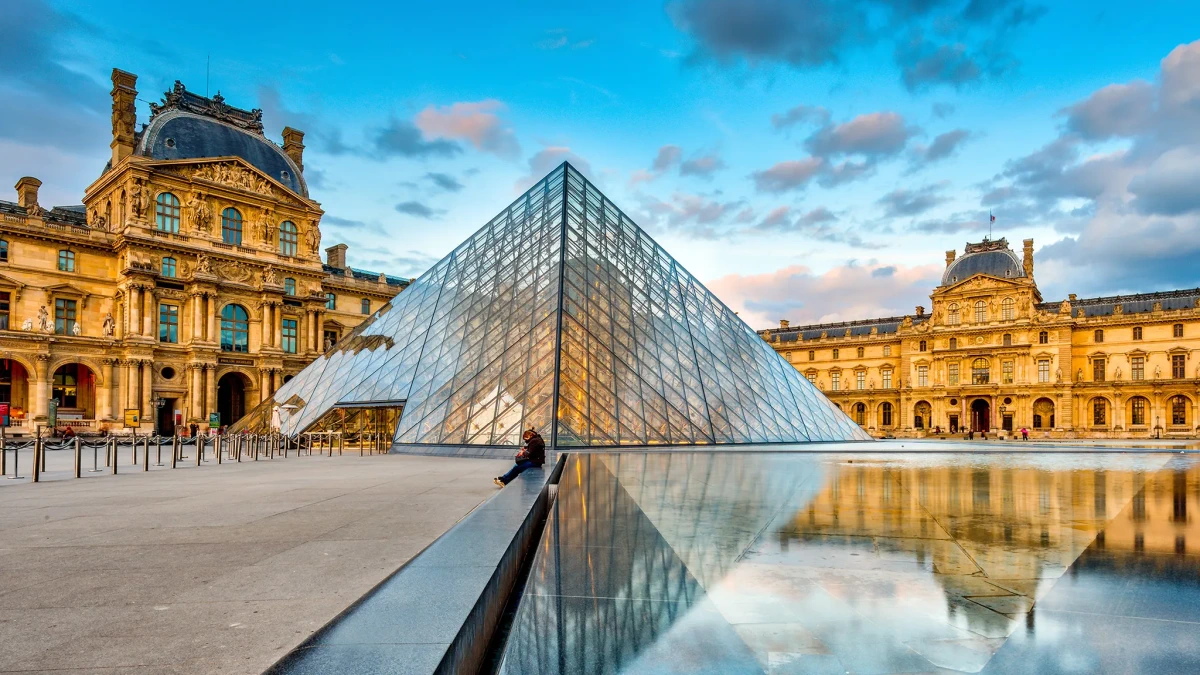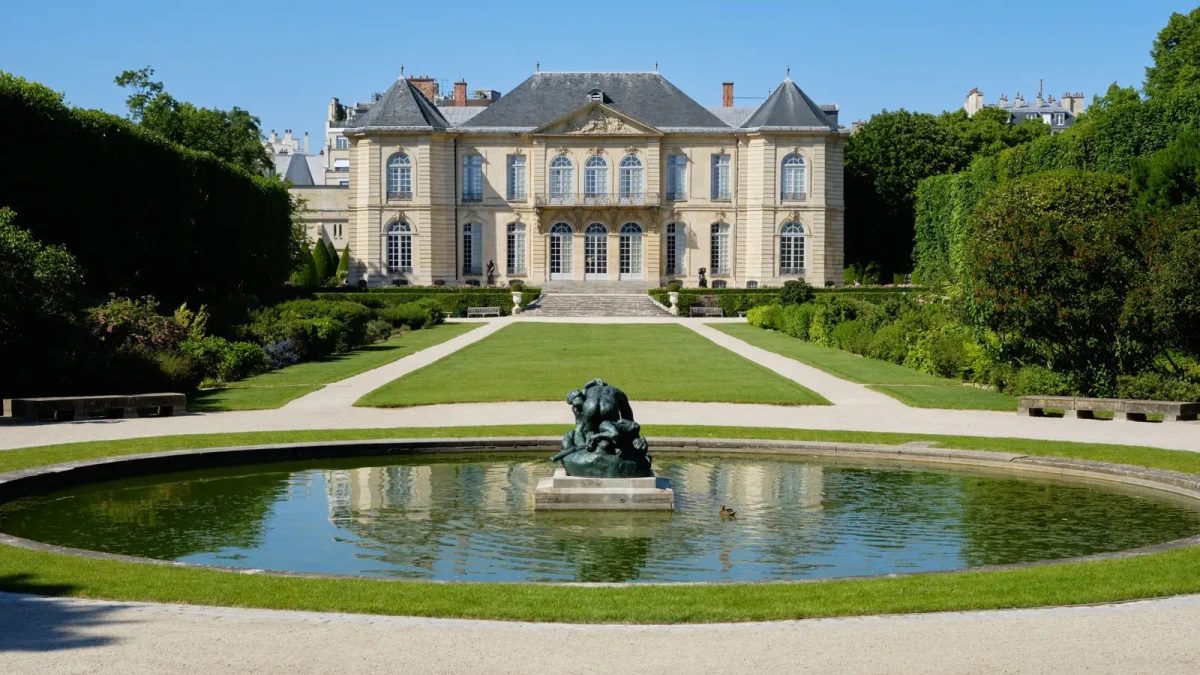The Arc de Triomphe, situated in the heart of Paris, is more than just an architectural marvel; it's a testament to the indomitable spirit of the French people. This grand monument has stood tall for centuries, witnessing the unfolding of history and commemorating triumphant moments. In this article, we delve deep into the Arc de Triomphe, uncovering its history, significance, and practical information for those planning a visit.
Note: This article contains affiliate links. In case you purchase something through one of these links, we may receive a small commission at no extra cost for you. Thank you for helping us keep creating the free content on this website!
Arc de Triomphe: A Triumph of Architecture and Symbolism
The Arc de Triomphe is a colossal arch that dominates the Place Charles de Gaulle square, formerly known as Place de l'Étoile. It stands as a tribute to the French army's victorious campaigns, particularly during the Napoleonic era. Commissioned by Napoleon Bonaparte himself in 1806, this arch was intended to honor the soldiers' sacrifices and celebrate the nation's unity.
The Arc de Triomphe stands as an iconic symbol of both architectural brilliance and historical significance, captivating the hearts and minds of visitors from around the world. Situated at the western end of the Champs-Élysées, this monumental arch serves as a testament to the enduring power of human creativity, engineering prowess, and the profound symbolism it embodies.
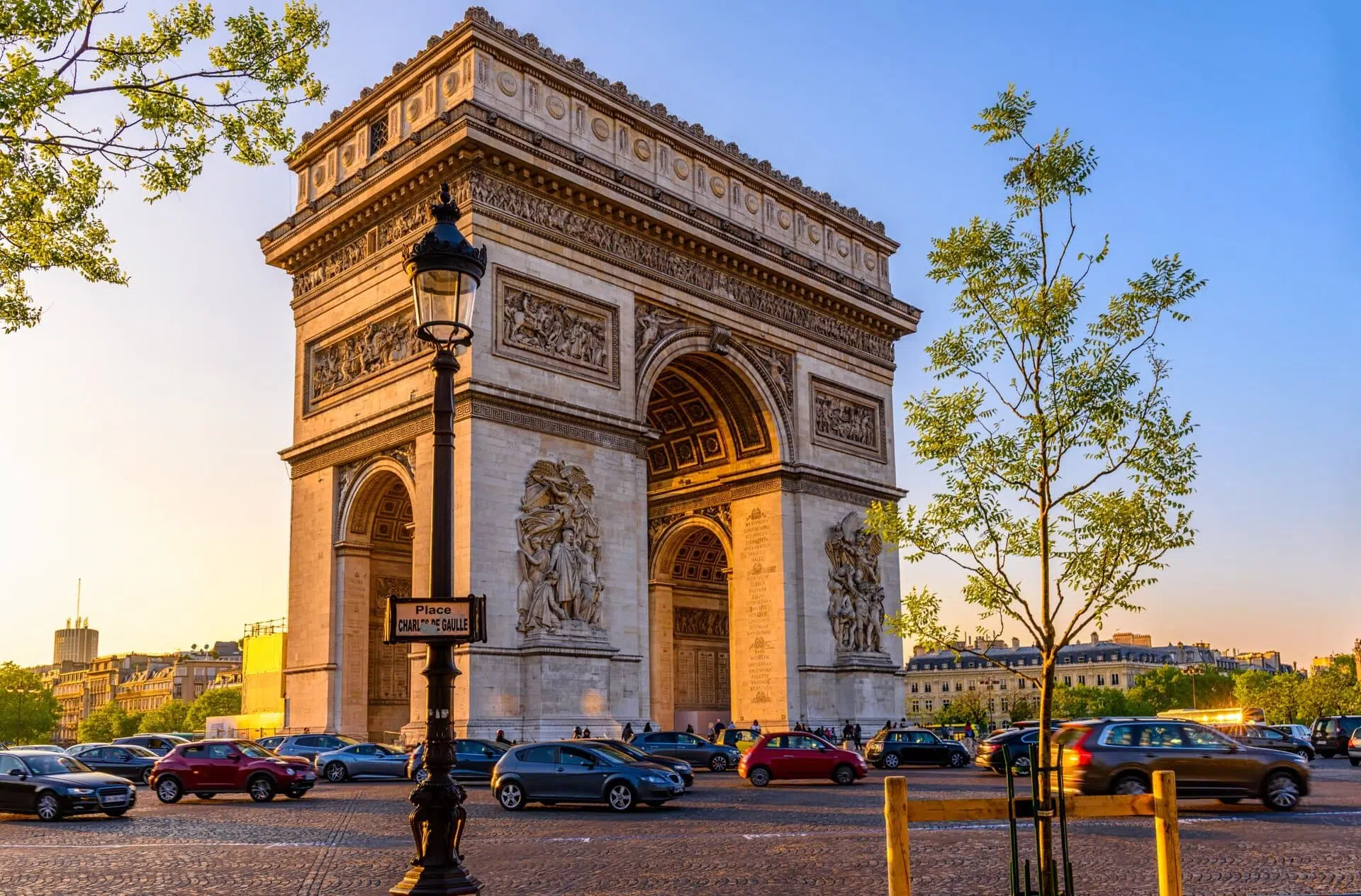
Designed by the renowned architect Jean Chalgrin, the construction of the Arc de Triomphe began in 1806 under the orders of Napoleon Bonaparte, the military and political genius who aimed to honor the triumphs of the French army and commemorate his own victories. This arch, spanning an impressive 50 meters in height and 45 meters in width, showcases a harmonious blend of neoclassical and Empire architectural styles, drawing inspiration from the ancient Roman triumphal arches. The symmetrical design, intricately carved reliefs, and meticulous attention to detail showcase the architectural excellence of the time.
The Arc's grandeur, however, extends far beyond its architectural magnificence. It serves as a vivid embodiment of symbolism, encapsulating various layers of meaning that resonate both with France's historical journey and broader human values. At its core, the arch stands as a tribute to the French soldiers who sacrificed their lives for their country during the Revolutionary and Napoleonic Wars. Its prominent location, at the heart of the city, underscores the nation's commitment to honoring its defenders and heroes, while reminding citizens and visitors alike of the cost of freedom and the enduring spirit of resilience.
The intricate sculptural reliefs that adorn the Arc's facade serve as visual narratives, recounting pivotal moments in France's military history. These intricate carvings portray scenes of triumph, valor, and sacrifice, paying homage to the brave souls who fought for their nation. Notably, the Tomb of the Unknown Soldier lies beneath the arch, a poignant reminder of the countless anonymous individuals who perished in the conflicts. This tomb has become a place of solemn reflection, inviting people to contemplate the broader themes of duty, honor, and the collective sacrifices that bind societies together.
Furthermore, the Arc de Triomphe is situated at a crossroads that radiates numerous avenues, symbolizing the interconnectedness of history, culture, and human experiences. The convergence of these thoroughfares mirrors the convergence of ideas, aspirations, and the shared pursuit of progress. It acts as a physical and metaphorical intersection of different epochs, where the past meets the present and the future.
Regrettably, the construction spanned such an extended duration that both Napoleon I and Jean Chalgrin, the commissioner and original architect, tragically could not witness its completion.
As a symbol of endurance and resilience, the Arc de Triomphe has borne witness to countless historical events, from celebrations of victory to somber commemorations of loss. It survived the ravages of time, including two World Wars, serving as a testament to human determination and the indomitable spirit of France.
As visitors gaze upon this iconic monument, they not only witness an architectural masterpiece but also connect with the enduring values that bind humanity together.
The History of the Arc de Triomphe
Once the Place de l'Étoile was earmarked as the location for the Arc de triomphe, architects Jean-François Thérèse Chalgrin and Jean-Arnaud Raymond sketched out a series of blueprints. They specifically settled on an arch sporting a straightforward aperture, as it was also envisioned to double as an entryway to the city.
This architectural preference pays a direct homage to ancient arches like Rome's Arch of Titus (85 AD). Amidst the myriad fountains of inspiration that fed the creative well of these architects, one can also pinpoint the Arch of Saint-Denis, crafted by Blondel, or even the Arch of Constantine in Rome (315 AD), which Attica and the Corinthian order adorned.
April 2, 1810, marked the union of Napoleon I with Marie-Louise of Austria. The imperial duo departed from the Palace of Saint-Cloud, the setting of the civil wedding the prior day, en route to the Louvre Palace to solemnize their nuptials in a religious ceremony.
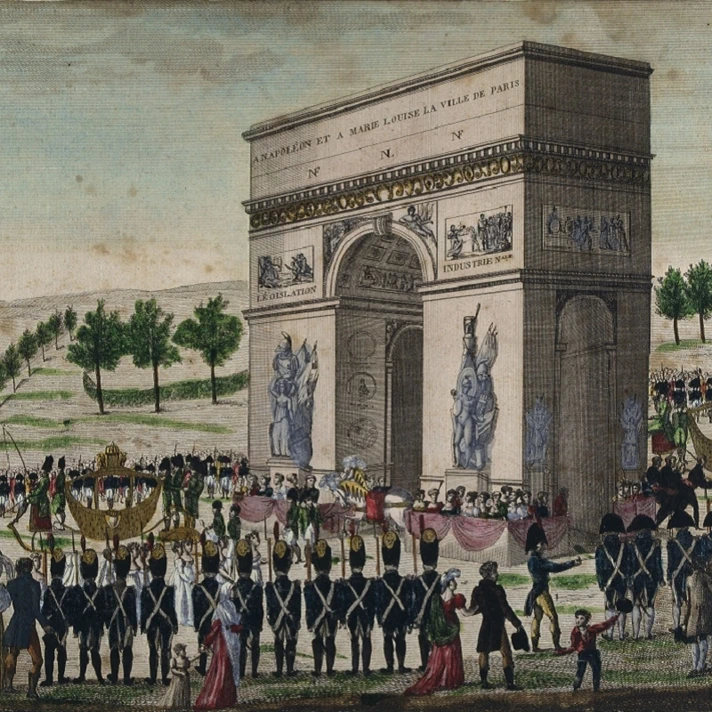
Their journey encompassed an entry into Paris through the iconic Place de l'Étoile. At that juncture, the construction of the Arc de triomphe was far from completion. The foundational bases of the four pillars were scarcely peeking above the ground. Consequently, a decision was reached to craft a true-to-life model. Chalgrin commissioned Louis Laffitte to craft an arch adorned with painted frames and canvas, enlisting a legion of five hundred workers to meet the imminent deadline. Yet, the carpenters chose to wield a strike as a protest against their working conditions and meager remuneration. While six of them were apprehended under the Prefect of Police's decree, the remainder witnessed their wages escalate from 4 francs per workday to 24 francs per laborious day.
The temporary construction's cumulative expenditure tallied up to 511,000 francs, affording architect Chalgrin an avenue to infuse alterations into his plans, thereby incorporating projections, the elimination of pedestals, and a melange of ornamental selections for the facades.
Tragedy struck on January 20, 1811, as Chalgrin succumbed to fate, the pillars of the Arc de triomphe soaring merely a dozen meters into the heavens—equivalent to the vault's base. Stepping into Chalgrin's shoes was his protégé, Louis-Robert Goust, inheriting the helm of the ongoing project.
In a twist that might astonish, the Arc de Triomphe doesn't claim the title of the world's largest arch. Once holding that distinction upon its construction, the crown was yielded in 1922 to the Arch of Triumph situated in Pyongyang, North Korea.
Following Napoleon's downfall and the ascent of Louis XVIII, the construction of the Arc de triomphe was brought to a standstill. 1814 saw architect Bernard Poyet suggesting the demolition of existing pillars. Despite his proposal, Louis XVIII resisted the notion, albeit abstaining from resuming the suspended construction. This project, conceived under Napoleon's rule, failed to captivate the minds of the monarchists. A slew of proposals came to the fore between 1814 and 1823, yet none managed to seize the king's undivided attention.
The turning point materialized on October 9, 1823, with Louis XVIII decreeing the completion of the Arc de triomphe with a fresh dedication. The king's decision aimed not at commemorating the imperial army, but rather the Army of the Pyrenees. Helmed by Louis Antoine de Bourbon, the Duke of Angouleme and nephew to Louis XVIII, this army had just reinstated the Spanish monarch, Ferdinand VII, to his throne. France laid claim to this triumph as its own.
Resumption of construction unfolded in a gradual cadence, with Louis-Robert Goust collaborating alongside another architect, Jean-Nicolas Huyot. Together, they embraced Chalgrin's designs while seamlessly weaving in additional columns to the facades. Come 1824, Louis XVIII's reign was succeeded by his brother, Charles X.
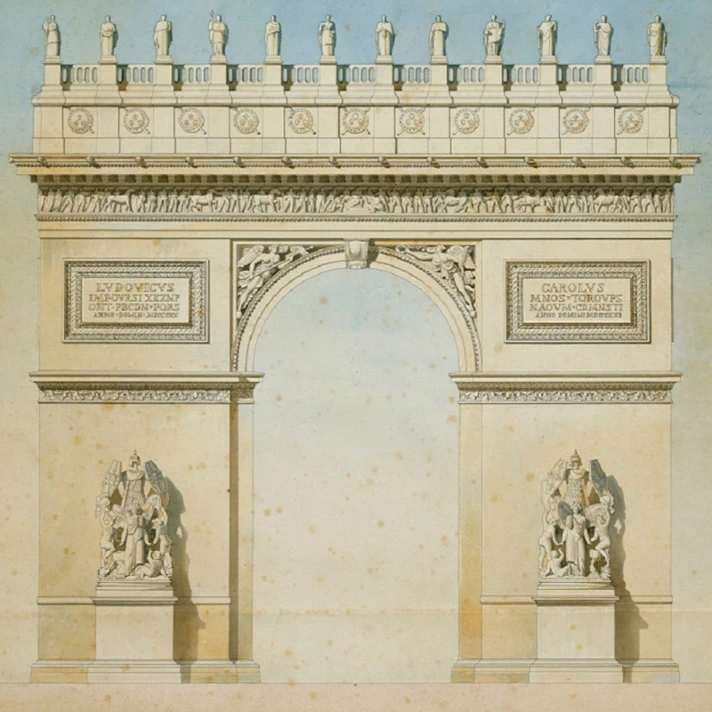
Undeterred by the changing of the guard, Charles X sustained the monument's construction, adhering to Louis XVIII's aspirations. By 1825, Huyot found himself ousted due to his proposition of columns on the facades, though he was reinstated in 1826. In tandem, Charles X enforced the reverence of Chalgrin's designs. Concurrently, an assembly of architects convened, orchestrating discussions encompassing the decorative motifs. This council agreed upon bedecking the vault with 21 caissons adorned with rosettes, sculpting high-relief paintings onto the facades, and employing Chérence stone (Vexin) to carve the entablature's sculptures.
By 1828, the monument had soared to the architrave of the entablature. A marble plaque, etched with the new dedication to the Army of the Pyrenees, was duly affixed to one of the pedestals on July 29, 1829. The year 1830 arrived with Goust's departure from the project, leaving Huyot to steer the course solo. Huyot laid before Charles X a concept to embellish the upper cornice with 36 statues encapsulating the essence of France's eminent cities.
The script of history would unveil its next chapter on August 2, 1830, as the French populace mounted a fervent uprising against the monarchy. Over 20,000 individuals rallied around the Arc de triomphe, under the command of General Pujol, patriots united in demanding Charles X's abdication—an ultimatum ultimately signed from the confines of Château de Rambouillet.
The revolutionary days of July 1830, referred to as the Trois Glorieuses, ushered in a fresh political epoch. Louis-Philippe I ascended the throne, juxtaposing himself against his predecessors with a commitment to harmony, branding himself as the King of the French.
However, the construction of the Arc de Triomphe, suspended anew, appeared hesitant to recommence. The circumstances grew graver, exacerbated by Huyot surpassing financial allocations. On July 31, 1832, Louis-Philippe entrusted Guillaume Abel Blouet with the task of culminating the Arc de triomphe's construction, introducing a novel dedication honoring the Armies of the Revolution and the Empire.
Simultaneously, Adolphe Thiers, the Minister of the Interior, embarked on commissioning various sculptors to conjure allegorical embellishments. Thus, a consortium of artists including Cortot, Etex, Rude, Lemaire, Seurre, Feuchère, Chaponnière, Gechter, Marochietti, Pradier, Bra, Valois, De Bay, Jacquot, and Laitie were mobilized to breathe life into high reliefs, friezes, spandrels, shields, and the balustrade adorning the monument.
By February 20, 1836, Lieutenant General Saint-Cyr Nugues unveiled three rosters: 30 pivotal battles from the Revolution and the Empire, to grace the attic, along with 96 feats of valor and 384 generals adorning the pedestals.
July 29, 1836, etched history as the Arc de triomphe was finally inaugurated after three decades of construction. The pedestals bore the unveiled list of names, yet the grandiose celebration intended for the occasion was thwarted by fears of a potential attack against King Louis-Philippe. A mere eleven attendees graced the event: the Council of Ministers' leader, Adolphe Thiers, the Minister of Finance, Antoine Maurice Appolinaire Argout, six national guards, the monument's custodian, and two official guests.
Nightfall summoned a crowd that congregated around the illuminated Arc de triomphe, bathed in the glow of 700 gaslights. Subsequently, both the government and the architect found themselves contending with a tide of protest concerning the inscribed names on the pillars. The assurance came that all appeals were duly considered, with Blouet undertaking the task of appending 128 generals' names and 172 forgotten battles. In his 1837 opus "Les Voix Intérieures," Victor Hugo lamented the omission of his father, Jospeh-Léopold-Sigisbert Hugo, who had been appointed a General by Louis XVIII in 1814.
In the ensuing years, intermittent additions continued to shape the monument's narrative, a tapestry woven with care until 1895.
The Majestic Architecture of the Arc
The architecture of the Arc de Triomphe is a stunning blend of neoclassical and military styles. Its intricate carvings and detailed reliefs tell stories of historic battles and significant moments in France's history. The arch's height, spanning over 164 feet, makes it a visible landmark from various parts of the city, adding to its allure.
The architecture of the Arc de Triomphe is a stunning blend of Neoclassical and Empire styles, characterized by its monumental proportions, meticulous detailing, and symbolic elements. The arch spans an impressive 50 meters in width, 45 meters in height, and 22 meters in depth. Its facade is adorned with intricate bas-reliefs depicting scenes of victorious battles and important historical events.
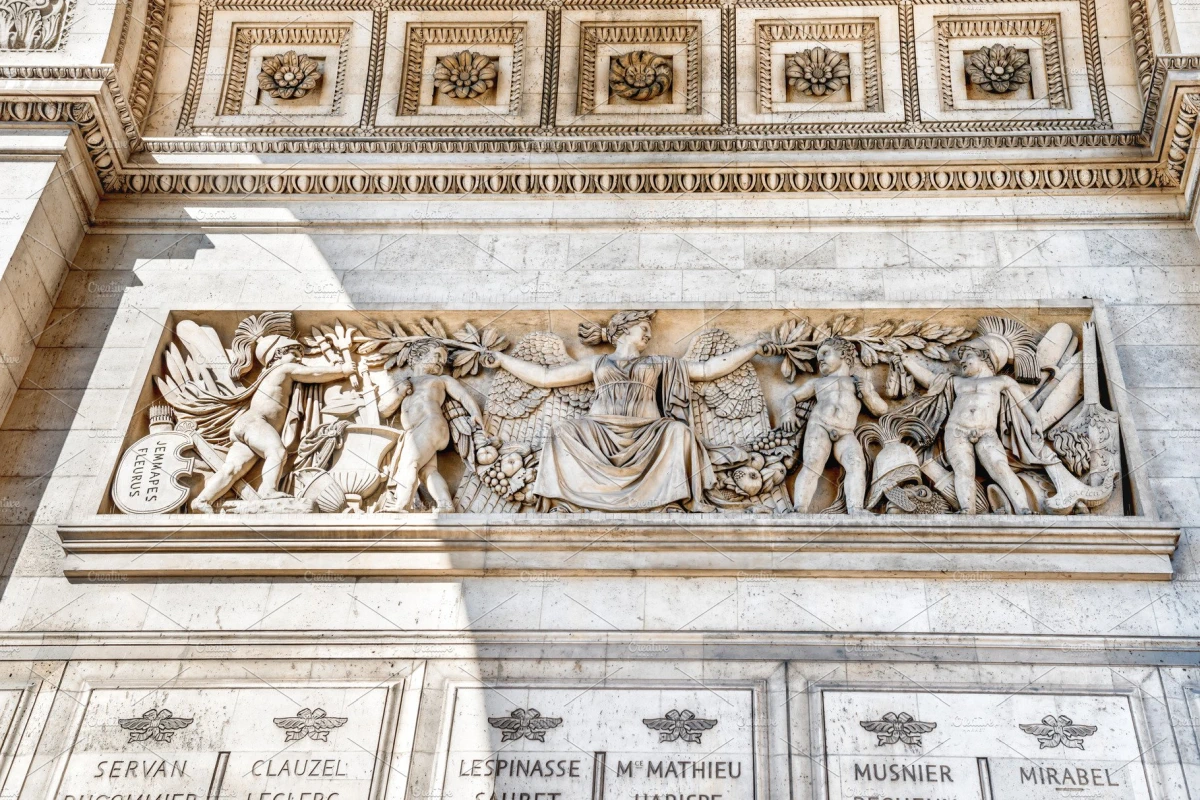
The central archway, flanked by Corinthian columns, provides the main passage for vehicular and pedestrian traffic, inviting visitors to enter and experience the monument up close. Above the arch, a frieze showcases allegorical figures representing various aspects of the French nation, such as Liberty, Equality, and Fraternity. Atop the arch stands a massive sculptural group known as the "Departure of the Volunteers of 1792," or simply "La Marseillaise," which depicts French soldiers and citizens ready to defend their homeland.
The Tomb of the Unknown Soldier beneath the Arc de Triomphe
The Tomb of the Unknown Soldier, enshrined beneath the grandeur of the Arc de Triomphe in Paris, stands as a poignant symbol of honor, sacrifice, and remembrance. This solemn monument serves as a testament to the countless anonymous soldiers who gave their lives in the service of their country, representing the broader narrative of sacrifice that transcends individual identities. Nestled within the heart of the City of Lights, the Tomb of the Unknown Soldier holds both historical significance and enduring emotional resonance, embodying the collective memory of a nation and its unbreakable bond with those who made the ultimate sacrifice.
Arc de Triomphe has since become a powerful emblem of the nation's martial prowess and resilience. However, beneath its massive arches lies a space that speaks to a different facet of war – the profound impact it has on individuals and families.
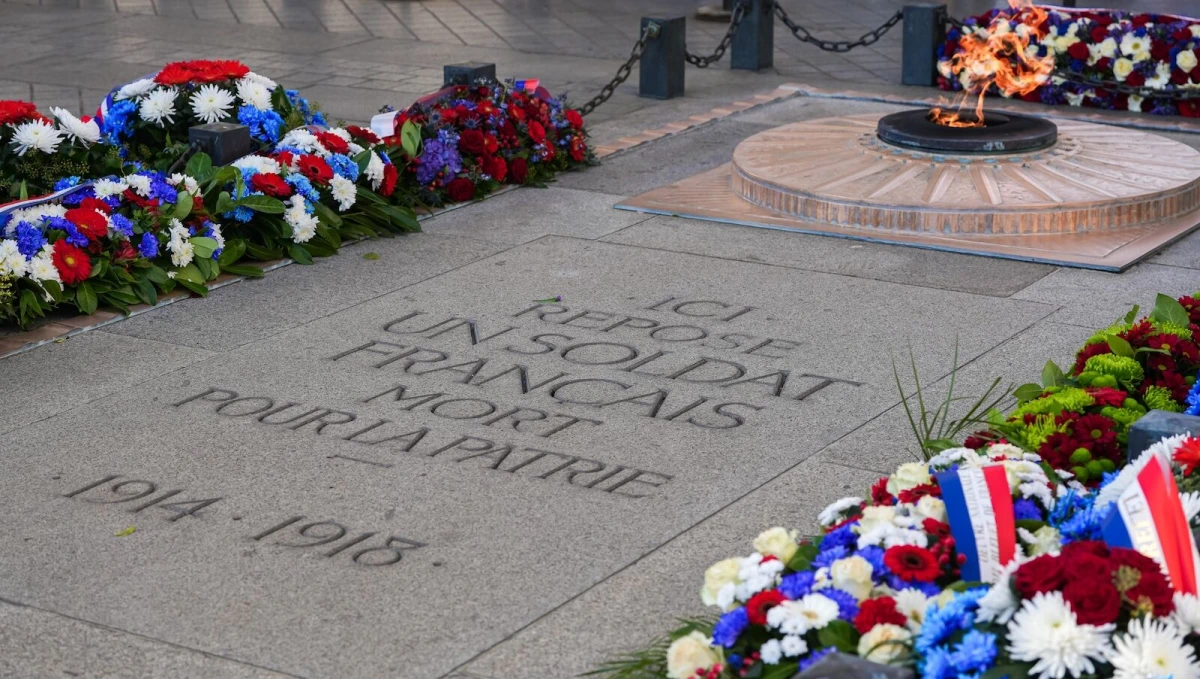
The concept of the Tomb of the Unknown Soldier emerged from the aftermath of World War I, one of the most devastating conflicts in human history. The idea was to create a monument that would honor the sacrifices of soldiers whose identities were lost to the horrors of battle. The first such tomb was established in Westminster Abbey in London in 1920, and its success inspired many nations, including France, to follow suit. Inaugurated on November 11, 1920, the Tomb of the Unknown Soldier beneath the Arc de Triomphe stands as a memorial to the 1.4 million French soldiers who perished in World War I.
The Tomb of the Unknown Soldier is not just a physical monument; it's a living representation of national reverence and commemoration. Guarded perpetually by the French Army's honor guard, the sentinel's vigil represents the nation's unending gratitude towards those who gave their lives. The Changing of the Guard ceremony, performed daily, is a somber ritual that captures the attention of visitors from around the world. The precise and deliberate movements of the guards underscore the respect and solemnity attached to the memory of these fallen soldiers.
The eternal flame that burns beside the tomb is another powerful symbol. Known as the "Flame of Remembrance," it was first lit in 1923 and has since remained an unceasing beacon of hope, a reminder that even in the darkest times, the memory of those who sacrificed their lives will never fade.
While the Tomb of the Unknown Soldier beneath the Arc de Triomphe holds immense significance for France, its message is universal. The tomb serves as a poignant reminder that the human cost of war knows no boundaries. It's a place where people from all walks of life and corners of the globe can come to pay their respects, to reflect on the futility of conflict, and to reaffirm their commitment to peace.
Unveiling the Historical Significance
As visitors approach the Arc de Triomphe, they step into the footsteps of history. From Napoleon's return from Elba to the repatriation of soldiers' remains from World War I and II, the monument has witnessed it all. It symbolizes the resilience of the French people and their enduring spirit, standing tall despite the challenges faced by the nation.
The historical significance of the Arc de Triomphe extends far beyond its impressive architecture. It serves as a memorial to the countless lives sacrificed for the ideals of liberty, equality, and fraternity. The Tomb of the Unknown Soldier, located beneath the arch, pays homage to the unidentified soldiers who lost their lives during World War I. This solemn reminder of the human cost of conflict reinforces the monument's significance as a site of remembrance and contemplation.
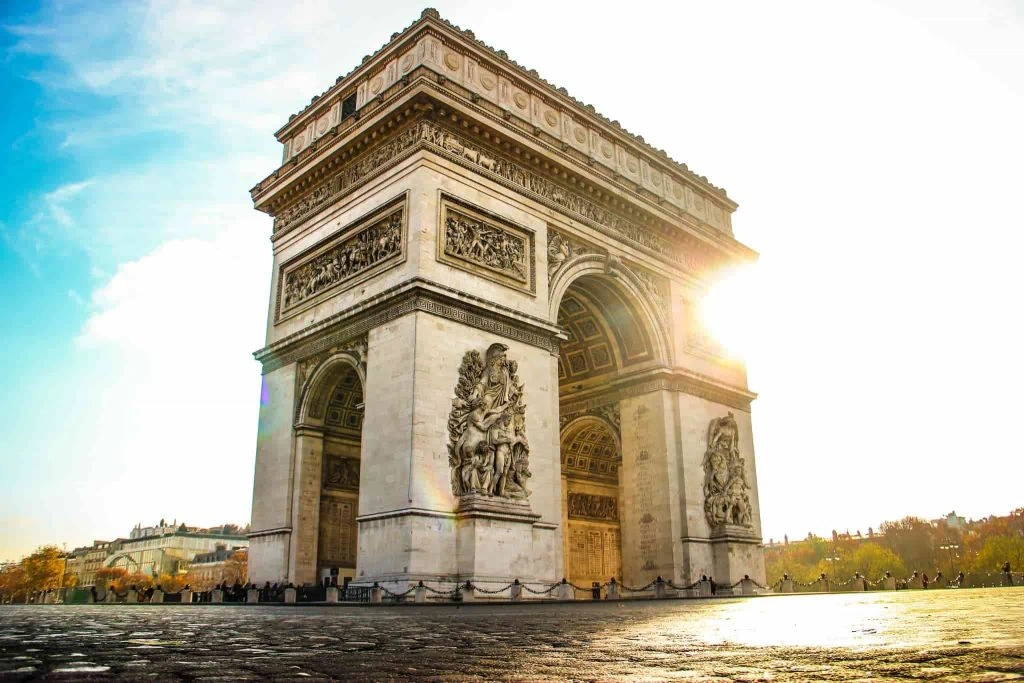
The Arc de Triomphe's symbolism is not limited to its military and political associations. Its position at the convergence of multiple avenues creates a visual link between various parts of Paris, representing the unity of the city and the nation itself. Furthermore, the monument's central location has made it a site for countless celebrations, demonstrations, and national events throughout history. From military parades to the annual Bastille Day festivities, the Arc de Triomphe has witnessed and participated in France's evolving identity.
One cannot discuss the historical significance of the Arc de Triomphe without acknowledging the emotions it evokes and the narratives it encapsulates. For the French people, it embodies the spirit of resilience and determination, serving as a reminder that challenges can be overcome with unwavering commitment. The monument has seen moments of both triumph and tragedy, reflecting the complex tapestry of a nation's history. The struggle for freedom, the pursuit of justice, and the defense of democracy are all encapsulated in the arch's colossal stone form.
In the modern era, the Arc de Triomphe continues to inspire awe and reflection. Its towering presence remains an icon of Paris, attracting millions of visitors annually who seek to immerse themselves in the grandeur of French history. It stands as a guardian of collective memory, reminding us that history is not just a chronicle of events but a narrative woven from the threads of human courage and sacrifice.
From its genesis, the Arc de Triomphe stood as a tribute to the valor of the French Army, its noble pillars rising like sentinels of history to enshrine the triumphs that have graced the annals of France.
Exploring the Surroundings: Champs-Élysées and Beyond
The Arc de Triomphe serves as the epicenter of the radiating twelve avenues, including the famous Champs-Élysées. This vibrant thoroughfare is lined with shops, cafes, theaters, and showcases the city's elegance. Visitors can enjoy leisurely strolls, shop for luxury brands, and savor French delicacies while soaking in the aura of the majestic monument.
Champs-Élysées: The Avenue of Elegance
Stretching from the Place de la Concorde to the Arc de Triomphe, the Champs-Élysées is a boulevard synonymous with elegance, luxury, and cultural significance. Lined with high-end boutiques, world-renowned restaurants, and theaters, this avenue is a magnet for both Parisians and tourists. The allure of Champs-Élysées lies not only in its upscale shopping and dining opportunities but also in its historical value. From hosting grand parades to witnessing monumental moments in French history, the avenue has borne witness to the nation's evolution.
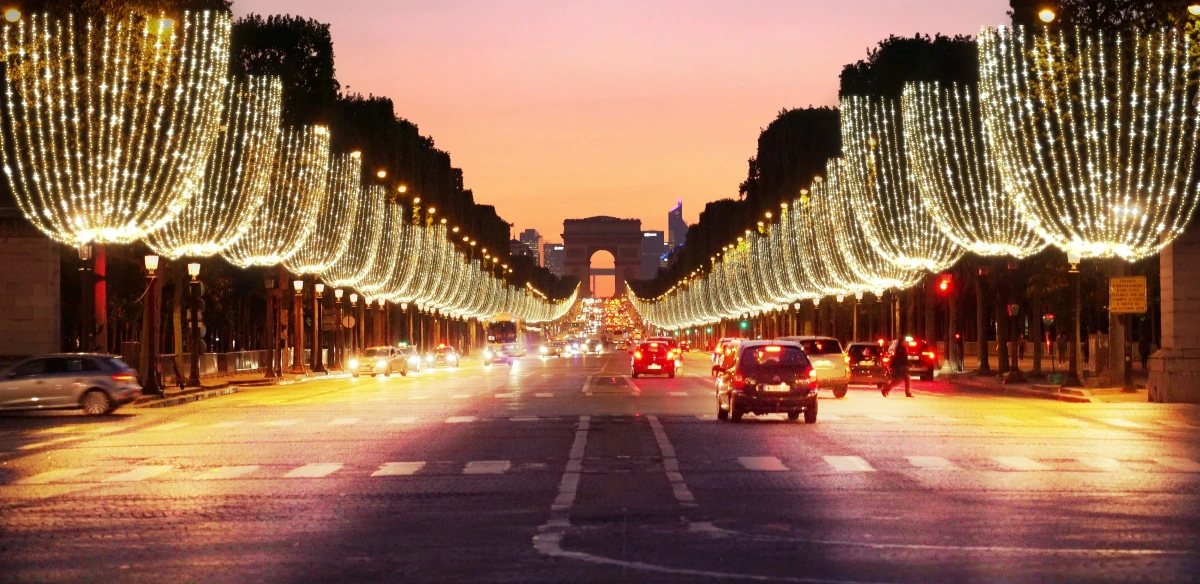
Beneath the Surface: The Spirit of Paris
Beyond the immediate splendor of Champs-Élysées and the Arc de Triomphe lies the true essence of Paris – a city steeped in culture, art, and diversity. A short stroll away leads to the Trocadéro, offering captivating views of the Eiffel Tower across the Seine River. Further exploration takes you to the bohemian neighborhood of Montmartre, where cobbled streets wind past charming cafés and the iconic Sacré-Cœur Basilica. The Louvre Museum, housing an unparalleled collection of art and history, is another testament to the city's enduring cultural significance.
Tips and Tricks for visitors
Planning a visit to the Arc de Triomphe? Here are some key details to keep in mind:
- The Arc de Triomphe welcomes visitors every day, except for certain public holidays. Be sure to check the official website for the latest information on opening hours and ticket prices.
- The monument is equipped with facilities for disabled visitors, including ramps and elevators. Wheelchair access is available, ensuring that everyone can experience the grandeur of the Arc.
- For breathtaking panoramic views of Paris, don't miss the opportunity to ascend to the top of the Arc de Triomphe. The observation deck offers an unparalleled vantage point to admire the city's landmarks, including the Eiffel Tower.
- The Arc de Triomphe houses the Tomb of the Unknown Soldier, marked by an eternal flame. This poignant memorial honors the soldiers who lost their lives in World War I.
- Immerse yourself in history by visiting the Arch Museum located within the monument. Discover artifacts, artworks, and historical exhibitions that shed light on the monument's significance.
Conclusion
The Arc de Triomphe stands not only as an architectural masterpiece but as a powerful symbol of triumph, unity, and resilience. From its rich history to its commanding presence, this monument continues to captivate visitors from around the world. As you stand beneath its grand arches, you can't help but feel a deep connection to the past and an appreciation for the enduring spirit of the French people.
FAQs about Arc de Triomphe
Can I climb to the top of the Arc de Triomphe?
Absolutely! Visitors can climb to the top of the Arc de Triomphe for a stunning view of Paris and its iconic landmarks.
Is the Arc de Triomphe accessible for wheelchair users?
Yes, the monument is accessible for wheelchair users, with ramps and elevators available for ease of movement.
Are there guided tours available?
Yes, guided tours are offered for those who wish to delve deeper into the history and stories behind the Arc de Triomphe.
Can I purchase tickets online in advance?
Yes, purchasing tickets online in advance is recommended to avoid long queues at the ticket counter.
What is the significance of the Eternal Flame?
The Eternal Flame honors the memory of soldiers who died in World War I and remains a symbol of remembrance.
Are pets allowed inside the monument?
Unfortunately, pets are not allowed inside the Arc de Triomphe, with the exception of guide dogs.
Site location: Pl. Charles de Gaulle, 75008 Paris
GPS coordinates: 48.873693, 2.295251
Google Photos: Click here
For more content and exciting articles, follow our site, where we regularly update our column to bring you the best ideas for events or things to do in Paris!






